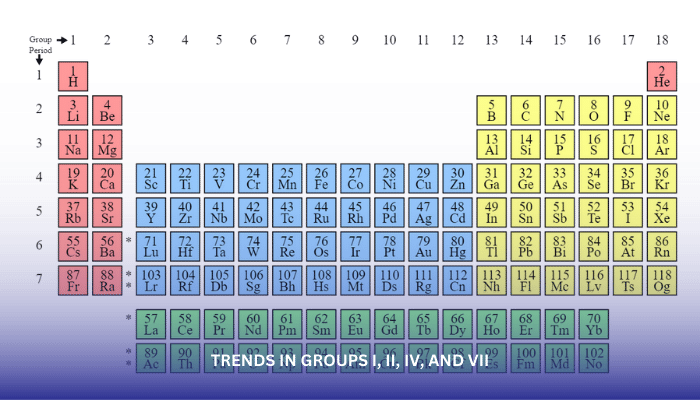
Learning Outcomes:
i. Identify the general trends in physical properties (melting point, boiling point, ionization energy, electronegativity) across Groups I, II, IV, and VII of the periodic table.
ii. Explain the relationship between these trends and the electron configurations of elements within each group.
iii. Analyze the variations in oxidation states exhibited by elements in Groups I, II, IV, and VII.
iv. Apply the concept of effective nuclear charge (ENC) to explain the trends in ionization energy across Groups I, II, IV, and VII.
Introduction:
The periodic table is a powerful tool for organizing and understanding the chemical behavior of elements. By grouping elements based on similar electron configurations, the periodic table reveals patterns and trends in their properties. In this lesson, we will focus on Groups I, II, IV, and VII, exploring the trends in physical properties and oxidation states within these groups.
i. Physical Properties:
Melting and Boiling Points: Melting and boiling points generally increase down a group, reflecting the increasing number of electrons and the weakening of intermolecular forces.
Ionization Energy: Ionization energy generally increases across a group as atomic size decreases and effective nuclear charge (ENC) increases.
Electronegativity: Electronegativity generally decreases down a group as atomic size increases and electron shielding becomes more effective.
ii. Oxidation States:
Group I (Alkali Metals): Alkali metals exhibit a consistent oxidation state of +1 due to the loss of their outermost valence electron.
Group II (Alkaline Earth Metals): Alkaline earth metals typically exhibit an oxidation state of +2 due to the loss of their two outermost valence electrons.
Group IV (Carbon Group): Elements in Group IV exhibit a range of oxidation states, including -4, -2, 0, +2, and +4. The specific oxidation state depends on the bonding environment.
Group VII (Halogens): Halogens typically exhibit an oxidation state of -1 due to the gain of one electron to achieve a full valence electron shell.
iii. Effective Nuclear Charge (ENC):
Effective nuclear charge (ENC) is the net positive charge experienced by an electron in an atom. It considers the attraction of the nucleus and the shielding effect of inner electrons. ENC increases across a period and down a group. The increasing ENC across a period explains the trend in ionization energy, as the electron being removed is increasingly attracted to the nucleus. The decreasing ENC down a group explains the trend in electronegativity, as the outer electrons become more shielded from the nucleus's attraction.
The trends observed in Groups I, II, IV, and VII provide valuable insights into the chemical behavior of elements within these groups. Understanding these trends allows us to predict physical properties, oxidation states, and reactivity patterns. The concept of ENC further enhances our understanding of these trends, providing a deeper explanation for the observed behavior.